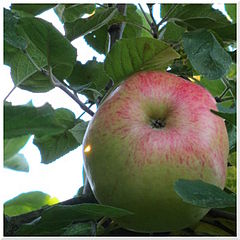Dülmen autumn rose apple
| Dülmen autumn rose apple | |
|---|---|

|
|
| Art | Cultivated apple ( Malus domestica ) |
| origin | Dülmen |
| known since | around 1870 |
| ancestry | |
|
Cross of |
|
| List of apple varieties | |
Dülmen autumn rose apple is a variety of the apple ( Malus domestica ). It probably originated in Dülmen around 1870 from a seedling of the “Gravensteiner” variety. A synonym for the variety is "Dülmener Rosenapfel", "Dülmener Rose" or "Dülmer Rose".
Auditor Ludwig Bielefeld describes in the Dülmener Heimatbl Blätter from 1927 that the variety is managed by regional tree nurseries . He names three companies, of which only the latter still exists:
- Tree nursery Gebr. Hanses, Münster-Hiltrup
- Lackmann Nursery, Olfen
- Sennekamp Nursery, Senden
The Sennekamp tree nursery plays a special role as the spread of the varieties - at least in the Westphalian Münsterland - probably began from here. Due to its typical shape, the variety is divided into the group of rose apples, a subgroup of Kalville apples , according to the classification according to Johann Ludwig Christ . The classification of apple varieties according to this system can be seen as a relic. All that remains is the name affix, as it has also been preserved, for example, with Berner Rosenapfel , Moringer Rosenapfel , Virginischer Rosenapfel etc.
The Dülmen rose apple appeared for the first time at a fruit exhibition in Greiz (Thuringia) in the 1870s, an important center of fruit growing in the German Empire at the time.
In the Westphalian Münsterland, the engineer from Dülmen, master trainer Bröder, played a key role in the regional distribution. He was in contact with the famous apple researcher Eduard Lucas , the founder of the Pomological Institute in Reutlingen (Baden-Württemberg). In 1878, railway master Bröder sent him fruits of the “probably new varieties” with the request to examine the “not yet described” variety “and to consider the above suggested name” . Edelreiser later also found their way to Reutlingen, where they were refined to test the variety. Railway master Bröder considered the new variety to be a variant of the Braunschweig pound apple, but noted a “peculiar aromatic scent” as the difference .
In the Geisenheimer Mitteilungen from 1911, a fruit grower (perhaps Carl Will) from Hildburghausen (Thuringia) is named, who began to multiply the variety in larger numbers.
description
This representation can be found in Petzold:
- “The medium-sized tree forms upright leading branches at an angle, which later incline or hang. The crown of larger trees is broad and protruding and pyramidal in low trunks. The variety is susceptible to viral flatness, but very resistant to scab , blood lice and aphids . The flowering period is only brief. The flowers develop terminally on short shoots or laterally on one- and two-year long shoots and are largely frost-resistant. The medium to large fruit is 83 mm wide and 68 mm high and weighs 195 grams. The smooth, fatty and crumbly skin is yellow-green to reddish-yellow in color and has light, dark-red stripes. The yellowish-white pulp is loose, fine-celled, juicy, harmoniously sweet-sour and fine-aromatic. The picking period begins in mid-September. It is ready for consumption from September to December. The apple can be stored and is suitable for fresh consumption and domestic processing. "
Engineer Bröder describes the variety (presumably in collaboration with Eduard Lucas) as follows:
- “(…) The fruit is large to very large and reaches a circumference of up to 29 cm at 400 m above sea level. The shape and color of the fruit is very similar to the Gravenstein apple. The closed calyx is quite flat. The latitude axis is usually larger than the height axis. The stem height (probably the stem cavity is meant) is of shallow depth, the stem is usually short. The fruit in the row of trees is deep yellow. On the sunny side, it is not very reddened and only rarely rusted. All in all, the apple already looks delicious on the tree. The flesh is yellowish-white, very juicy and has a fine, spicy taste. After a short storage of two to three weeks, it is ready to be enjoyed. It is a pre-winter fruit that should not be stored beyond December, otherwise a loss of taste occurs. The variety grows vigorously and healthily. Early and regular fruit set can be expected on wildlings. The fruits tend to form inside the crown, while the young shoots grow vigorously on the outside. Vegetable and animal pests avoid the tree, even the lice it is too rough. A strong pyramidal crown develops on the wildling pad (this is probably the seedling pad; author's note), which only bears fruit in the 7th or 8th year. A moderate pruning every three to four years is advisable for raising on a half trunk. The tree is resistant to the rust fungus. Since it is not a permanent apple (storage apple, author's note), plantation cultivation is not recommended (...) "
From today's perspective, Bröder's description is easy to understand. Grafting on seedling bases is no longer common today, with the exception of orchards. Instead, type rootstocks such as M 9 , M 26 or MM 106 ensure a regulated growth behavior, early and regular fruit set as well as large and even fruits with a relatively low crown volume.
literature
- Willi Berndt: Something from the “Dülmen rose apple”. In: Dülmener Heimatblätter. A. Laumann Verlag, Volume 3, 1960.
- Ludwig Bielefeld: The Dülmen rose apple. In: Dülmener Heimatblätter. A.-Laumann-Verlag, issue 11, 1927.
- Johann Ludwig Christ: Handbook on fruit tree cultivation and fruit teaching .. Frankfurt am Mayn, 1811.
- Herbert Petzold: Apple varieties. 3. Edition. Neumann Verlag, Leipzig / Radebeul 1979, p. 94.
Web links
- Fruit variety database Bund Lemgo: Dülmener Herbstrosenapfel
- Research on the origin of the variety: Dülmener Rosenapfel

